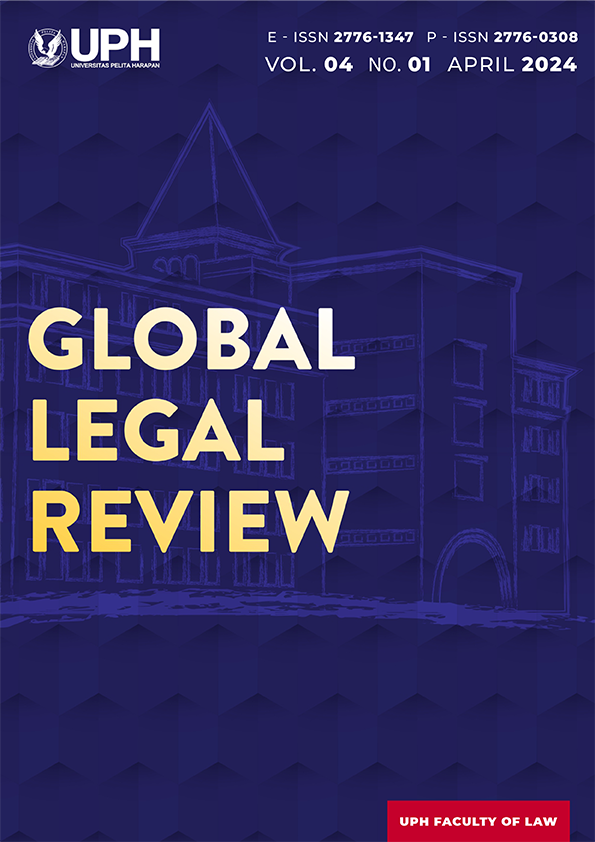Regulations on Access to Financial Information to Improve Taxpayer Compliance with Law No. 9/2017 and its Implementation Rules
DOI:
https://doi.org/10.19166/glr.v4i1.6348Kata Kunci:
Access to financial information, Automatic Exchange of Information, Common Reporting Standard, Tax Identification NumberAbstrak
The purpose of this research is to explore and analyze regulations for access to financial information for tax purposes to increase taxpayer compliance. The research approach in this study is qualitative normative based on literature and field studies in the form of collecting access data and following up on inbound and domestic AEOI based on access to information by tax administration. This study finds that for easy access to financial information for tax purposes both in the context of AEOI and the implementation of the tax laws, Law No. 9/2017 authorizes access to financial information to the Director General of Taxes (DGT) by setting aside the confidentiality of financial information in the Law of Tax Procedures and the Banking Law, access to banking financial information has positively increased tax compliance, but compulsory reporting of accounts with minimum balance of Rp1 billion have the potential to trigger rush of bank funds. On the other hand, it had reduced the effectiveness of Law No. 9/2017 to increase tax compliances for individuals who have accounts’ balance less than Rp1 billion at the end of the reporting calendar year. It can be suggested to amend the formulation of the provisions of Article 2 paragraph (3) of Law 9/2017 refers to the Common Reporting Standard (CRS) which must contain financial information, including NPWP with NIK (Resident Identification Number) for certainty and to eliminate doubts.
Referensi
Ali, Achmad. Menguak Teori Hukum, (Legal Theory) dan Teori Peradilan (Judicialprudence) Termasuk Interpretasi Undang-Undang (Legisprudence). Jakarta: Kencana, 2010.
Allingham, Michael G., and Agnar Sandmo. “Income Tax Evasion: A Theoretical Analysis.” Journal of Public Economics 1, no. 3-4 (November 1972): 323-338. https://doi.org/10.1016/0047-2727(72)90010-2.
Ariyanti, Fiki. “Alasan Menkeu Ubah Saldo Rekening Wajib Lapor Jadi Rp1 Milyar.” Liputan6.com, June 9, 2017. https://www.liputan6.com/bisnis/read/2984902/alasan-menkeu-ubah-saldo-rekening-wajib-lapor-jadi-rp-1-miliar.
Direktorat Jenderal Perimbangan Keuangan Kementerian Keuangan Republik Indonesia. “Nota Keuangan Beserta Anggaran Pendapatan Dan Belanja Negara Tahun Anggaran 2018.” Last modified September 6, 2017. https://djpk.kemenkeu.go.id/?p=5125.
Multazam, Ibnu, Ismansyah, and Wetria Fauzi. “Legal Certainty of Doctor Profession Insurance Claim in Bumiputera Muda 1967 General Insurance, Pekanbaru City.” International Journal of Multicultural and Multireligious Understanding 7, no. 10 (October 2020): 333-338. https://ijmmu.com/index.php/ijmmu/article/view/2099.
OECD. Peer Review of the Antomatic Exchange of Financial Account Information 2022. Paris: OECD Publishing, 2022.
Pohan, Chairil Anwar. Pedoman Lengkap Pajak Internasional. Jakarta: Gramedia Pustaka Utama, 2018.
Shioshvili, Irma. “General Antecedents of Philosophy by Gustav Radbruch.” Bulletin of the Georgian National Academy of Sciences 11, no. 2 (2017): 128-135. http://science.org.ge/bnas/t11-n2/21_Shioshvili.pdf.
Sinamo, Nomensen. Metode Penelitian Hukum. Jakarta: Bumi Intitama Sejahtera, 2009.
Soekanto, Soerjono and Sri Mamudji. Penelitian Hukum Normatif: Suatu Tinjauan Singkat. Jakarta: Raja Grafindo Persada, 2001.
Wignjosoebroto, Sritomo. “Ragam-Ragam Penelitian Hukum.” In Metode Penelitian Hukum, Konstelasi dan Refleksi, edited by Sulistyowati Irianto and Shidarta. Jakarta: Yayasan Pustaka Obor Indonesia, 2013.
Unduhan
Diterbitkan
Cara Mengutip
Terbitan
Bagian
Lisensi
Hak Cipta (c) 2024 Fung Njit Tjhai

Artikel ini berlisensiCreative Commons Attribution-ShareAlike 4.0 International License.
Authors who publish with this journal agree to the following terms:
1) Authors retain copyright and grant the journal right of first publication with the work simultaneously licensed under a Creative Commons Attribution License (CC-BY-SA 4.0) that allows others to share the work with an acknowledgement of the work's authorship and initial publication in this journal.
2) Authors are able to enter into separate, additional contractual arrangements for the non-exclusive distribution of the journal's published version of the work (e.g., post it to an institutional repository or publish it in a book), with an acknowledgement of its initial publication in this journal.
3) Authors are permitted and encouraged to post their work online (e.g., in institutional repositories or on their website). The final published PDF should be used and bibliographic details that credit the publication in this journal should be included.

